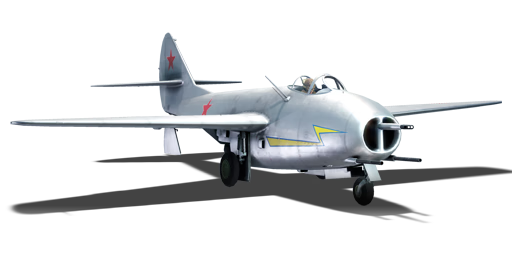



In February to April of 1945, after the capture of vast quantities of German jet technology at the end of the war, the design bureaus in the Soviet Union began developing the first jet powered aircraft of the USSR. Shortly after, a official directive called for a twin engine fighter-interceptor with heavy armament. Mikoyan stepped up to the task with their I-300 prototype, a simple pod-and-boom design with two RD-20 (reverse-engineered BMW 003 jet engines), armed with either a 57 mm or a 37 mm in addition to two 23 mm cannons. The aircraft was ready to fly on the same day as its main competitor, the Yak-15, and a simple coin flip between the two development teams on the airfield that day decided that the MiG would take off first that day, making it the very first Soviet jet aircraft to fly in history. Eventually, the 57 mm design was dropped after a few prototypes due to unreliability, weight issues, and the gases from the 57 mm gun firing (which was mounted in the center of the "nose") going into the intake and causing compressor stalls and engine flameouts. In the end, the 37 mm + 2 x 23 mm variant was chosen for production as the "MiG-9".
The MiG-9 has been in the game since the start of the Open Beta Test prior to Update 1.27. Being a very early pod-and-boom fighter powered by captured german axial-turbojet engines, it suffers from the same disadvantages as most early Soviet jets: Terrible acceleration, subpar manoeuvrability, and the tricky low velocity guns with a small ammo pool. However, when mastered, the MiG-9 is a force to be reckoned with in boom-and-zoom engagements, utilizing its higher speed than most adversaries and hard-hitting guns to shred unsuspecting planes with its altitude advantage. One must be wary of their energy state at all times, as this plane's horrible acceleration makes it difficult to recover lost energy.
flaps
flaps
flaps
brake
| Belt | Belt filling | Armor penetration (mm) at a distance: | |||||
|---|---|---|---|---|---|---|---|
| 10 m | 100 m | 500 m | 1000 m | 1500 m | 2000 m | ||
| HEFI-T/HEFI-T/API-T | 49 | 47 | 39 | 32 | 26 | 21 | |
| HEFI-T/HEF-I/HEF-I | 6 | 6 | 5 | 4 | 3 | 3 | |
| API-T | 49 | 47 | 39 | 32 | 26 | 21 | |
| Belt | Belt filling | Armor penetration (mm) at a distance: | |||||
|---|---|---|---|---|---|---|---|
| 10 m | 100 m | 500 m | 1000 m | 1500 m | 2000 m | ||
| AP-I/FI-T | 32 | 30 | 22 | 15 | 10 | 7 | |
| FI-T/AP-I/AP-I/AP-I | 32 | 30 | 22 | 15 | 10 | 7 | |
| FI-T/FI-T/FI-T/AP-I | 32 | 30 | 22 | 15 | 10 | 7 | |
| AP-I | 32 | 30 | 22 | 15 | 10 | 7 | |












Flight performance | |
|---|---|
Survivability |
|---|
Weaponry |
|---|